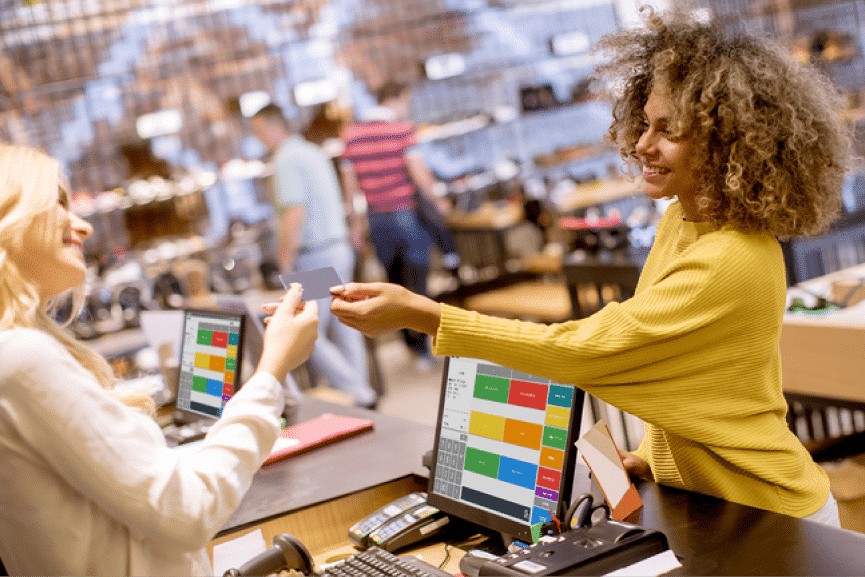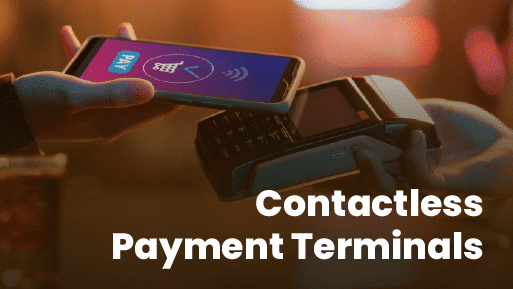
As a retailer, having the capability to accept secure contactless payments is crucial to meet evolving consumer preferences. In this blog, we’ll introduce you to contactless payment terminals, what they are, the types available, and critical features to look for.
We’ll also walk you through how to seamlessly integrate your contactless payment terminals into retail POS systems. Equipping your outlets with smooth contactless payment capabilities is critical to boosting convenience, transaction speed, and the overall shopping experience. Read on to learn more.
What Is a Contactless Payment Terminal?
A contactless payment terminal is an electronic device used to process card transactions without physical contact between the payment card and the terminal. These terminals use near-field communication (NFC) technology to interact with a contactless card or a mobile device, such as a smartphone or smartwatch, that supports contactless payments.
When a customer makes a payment, they simply hold their contactless card or device near the payment terminal when prompted. The terminal then communicates wirelessly with the card or device to transmit payment information securely. This process typically involves tokenization, replacing sensitive card details with a unique code (token) for each transaction. This enhances the security of the transaction and customer bank details.
Contactless payment terminals are designed for speed and convenience, allowing quicker transaction times than traditional chip-and-PIN or magnetic stripe transactions. They are widely used in retail environments and other merchant settings where fast and efficient payment processing is important.
Upgrade to contactless payment terminals today! Contact KORONA POS for cutting-edge solutions that streamline transactions.
Contact usTypes of Contactless Payment Terminals
There are three main types of contactless payment terminals:
Fixed terminals
Fixed terminals are permanently installed at the retail checkout counters. They typically have a straightforward interface, making it easy for cashiers to navigate through different payment options. Customers need to tap their card, smartphone, or wearable device near the contactless symbol on the terminal for contactless payments. This process is quick and intuitive. Here are some other benefits of fixed terminal terminals:
Integration with POS systems: These terminals are often integrated with the store’s point of sale system. This integration allows for efficient transaction processing, inventory management, and sales tracking. When a customer opts for contactless payment, the amount is automatically communicated to the terminal from the POS, reducing the chance of manual entry errors.
Versatility in payment acceptance: Besides contactless payments, these terminals can also process traditional magnetic stripe cards, chip cards, and mobile wallet payments, thereby offering greater flexibility to customers.
Mobile terminals
Mobile terminals, also known as mobile point of sale (mPOS) devices, are portable devices that allow merchants to accept payments on the go. They are typically smaller and lighter than traditional POS terminals, making them ideal for businesses that operate in multiple locations or at events. Mobile terminals can accept a variety of payment methods, including contactless and mobile payments.
Setup and integration: Setting up a mobile terminal is generally straightforward. Many systems are designed to be plug-and-play, requiring minimal technical knowledge.
User-friendly interfaces: The interfaces are typically user-friendly, with intuitive touchscreens and simple navigation.
Portability: Their compact size and wireless connectivity make them ideal for various settings, including retail, hospitality, and outdoor markets.
Battery life: Since these devices are portable, it is crucial to ensure that they are charged and ready for use.
Transaction limits: Some contactless payment methods have transaction limits, which might require alternative payment methods for larger purchases.
Integrated terminals
Integrated terminals are embedded in other devices, such as smartphones or self-checkout kiosks. The self-checkout technology allows customers to pay for all items quickly and easily without having to scan items one-by-one or wait for a cashier.
Below are a few more details about integrated terminals:
Integration with retail systems: These terminals are often part of a more significant point of sale system, integrated with inventory management and sales tracking. They can provide real-time data analytics for businesses, helping with inventory management and measuring customer behavior analysis.
Reduced wait times and increased order accuracy: Kiosks allow customers to place orders and pay independently, reducing wait times and queues, especially during peak periods. This self-service approach also minimizes human error, leading to improved order accuracy.
Cost: Initial setup and maintenance can be costly for some businesses.
Key Features to Look for in Contactless Payment Terminal
1. NFC connectivity
Look for the best payment terminals that support NFC technology. NFC allows customers to tap their contactless credit cards, mobile phones, or wearables to make secure payments without inserting a card. NFC also supports a variety of modern payment methods, including Apple Pay and Google Pay.
2. EMV chip card reader
Incorporating an EMV chip card reader is a critical feature for contactless payment terminals, ensuring heightened security and compliance with payment standards. EMV technology, representing Europay, MasterCard, and Visa, is more secure than magnetic stripe readers, as it generates a unique transaction code for each use.
3. Fast processing speeds
Fast processing speeds greatly enhance the efficiency of contactless payment terminals. In high-traffic retail settings, terminals that process transactions quickly can significantly reduce customer wait times. Choose a contactless payment terminal with fast processors for smooth transactions. Also, ensure the contactless payment terminal’s provider offers a system that integrates with any payment processor.
We WON’T. KORONA POS is not a payment processor.
That means we’ll always find the best payment provider for your business’s needs.
4. Integrated receipt printer
An integrated receipt printer in contactless payment terminals offers businesses a streamlined, space-saving solution. This feature immediately prints clear, legible receipts directly from the terminal. Cashiers don’t have to reach under the counter for a bulky separate printer during each transaction. Built-in printers also take up less counter space.
5. Customer display screen
A customer display screen guides customers through the payment process. Contactless payment terminals with customer display screens not only improve the user experience but can also serve as a tool for businesses to display promotional content or loyalty program details, adding value to the customer’s transaction experience.
Get Contactless Payment Terminals With KORONA POS

Customers increasingly expect the ability to tap their phone or card to pay rather than handling cash. As a retail business owner, you must be prepared to accept these frictionless payments.
That’s where KORONA POS comes in. KORONA POS enables you to accept all the popular contactless payment methods, including Apple Pay, Android Pay, and chip cards. Our point of sale seamlessly integrates contactless transactions into your existing systems. Whether you operate one shop or run a multi-store retail business, you’ll get detailed analytics and reporting on contactless purchases. We make it effortless to provide your customers with the contactless, secure purchasing that most consumers now demand.
Importantly, KORONA POS is designed to be adaptable, functioning not as a payment processor but as a POS that seamlessly integrates with any merchant service of your choice. This flexibility ensures you can tailor the system to fit your business needs and budget. Sign up today for a demo of KORONA POS.












